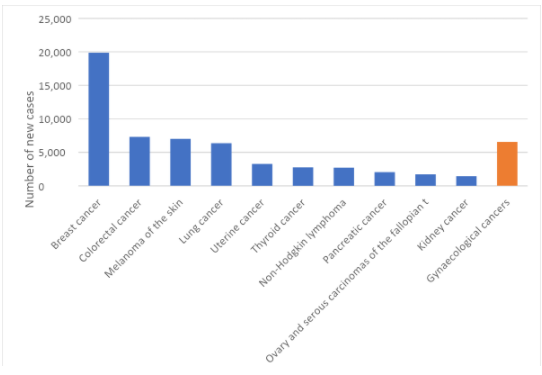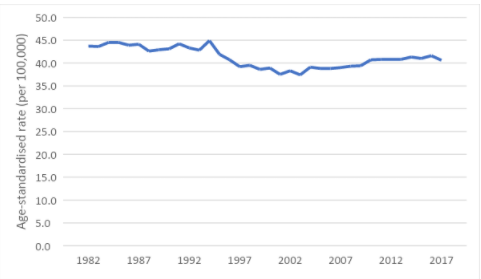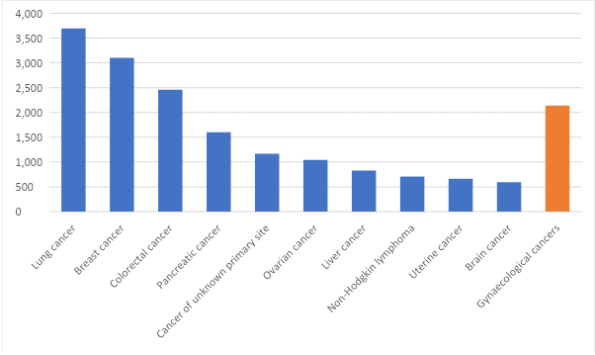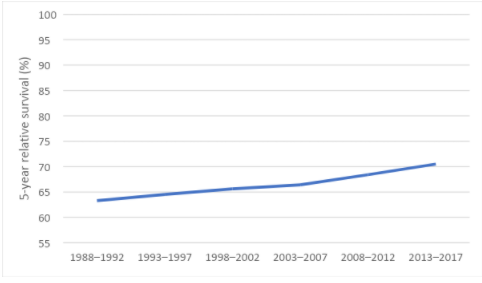The following material has been sourced from the Australian Institute of Health and Welfare
Gynaecological cancer incorporates ICD-10 cancer codes C51 (Malignant neoplasm of vulva), C52 (Malignant neoplasm of vagina), C53 (Malignant neoplasm of cervix), C54 (Malignant neoplasm of corpus uteri), C55 (Malignant neoplasm of uterus, part unspecified), C56 (Malignant neoplasm of ovary), C57 (Malignant neoplasm of other and unspecified female genital organs) and C58 (Malignant neoplasm of placenta).
Estimated number of new cases of gynaecological cancer diagnosed in 2021
 6,576 females
6,576 females
Estimated % of all new female cancer cases diagnosed in 2021
9.3%
Estimated number of deaths from gynaecological cancer in 2021
 2,139 females
2,139 females
Estimated % of all female deaths from cancer in 2021
9.9%
Chance of surviving at least 5 years (2013–2017)
71%
Females living with gynaecological cancer at the end of 2016 (diagnosed in the 5 year period 2012 to 2016)
21,087
New cases
In 2017, gynaecological cancer as a group represents 9.3% of cancers diagnosed in women and the most common gynaecological cancer was uterine cancer (see details on the uterine cancer page).
In 2017, there were 5,823 new cases of gynaecological cancers diagnosed in Australia. In 2021, it is estimated that 6,576 new cases of gynaecological cancers will be diagnosed in Australia. In 2021, it is estimated that a female has a 1 in 23 (or 4.4%) risk of being diagnosed with a gynaecological cancer by the age of 85.

Figure 1. Estimated most common cancers diagnosed among females, 2021
Notes
- Data sourced from AIHW Cancer Data in Australia 2021 web report and supplementary data tables
- More information about incidence rates for the most common cancers diagnosed can be found on the NCCI website in the ‘Cancer incidence’ section (https://ncci.canceraustralia.gov.au/diagnosis/cancer-incidence/cancer-incidence)
In 2017, the age-standardised incidence rate was 41 cases per 100,000 females. In 2021, it is estimated that the age-standardised incidence rate will be 42 cases per 100,000 females. The incidence rate for gynaecological cancers is expected to increase with age, peaking at age group 75–79 years.

Figure 2. Age-standardised incidence rates for gynaecological cancers, 1982 to 2017
Notes: Data sourced from AIHW Cancer Data in Australia 2021 web report and supplementary data tables
The number of new cases of gynaecological cancers diagnosed increased from 2,951 in 1982 to 5,823 in 2017. Over the same period, the age-standardised incidence rate decreased from 44 cases per 100,000 females in 1982 to 41 cases per 100,000 females in 2017.
Deaths
In 2019, gynaecological cancer as a group represents 10% of cancer related deaths in women and ovarian cancer was the most common cause of gynaecological cancer-related death.
In 2019, there were 2,150 deaths from gynaecological cancers in Australia. In 2021, it is estimated that there will be 2,139 deaths. In 2021, it is estimated that a female has a 1 in 71 (or 1.4%) risk of dying from a gynaecological cancer by the age of 85.

Figure 3. Estimated most common causes of cancer death among females, 2021
Notes
- Data sourced from AIHW Cancer Data in Australia 2021 web report and supplementary data tables
- More information about mortality rates for the most common causes of cancer death can be found on the NCCI website in the ‘Cancer mortality’ section (https://ncci.canceraustralia.gov.au/outcomes/cancer-mortality/cancer-mortality)
In 2019, the age-standardised mortality rate was 13 deaths per 100,000 females. In 2021, it is estimated that the age-standardised mortality rate will remain 13 deaths per 100.000 females). The mortality rate for gynaecological cancer is expected to increase with age.

Figure 4. Age-standardised mortality rates for gynaecological cancers, 1982 to 2019
Note: Data sourced from AIHW Cancer Data in Australia 2021 web report and supplementary data tables
The number of deaths from gynaecological cancers increased from 1,235 in 1982 to 2,150 in 2019. Over the same period, the age-standardised mortality rate decreased from 19 deaths per 100,000 females in 1982 to 13 deaths per 100,000 in 2019.
Survival
In 2013–2017, females diagnosed with gynaecological cancers had a 71% chance of surviving for at least five years compared to their counterparts in the general Australian population. Between 1988–1992 and 2013–2017, five-year relative survival for gynaecological cancers improved from 63% to 71%.

Figure 5. 5-year relative survival for gynaecological cancers, 1988–1992 to 2013–2017
Notes: Data sourced from AIHW Cancer Data in Australia 2021 web report and supplementary data tables
Prevalence
At the end of 2016, there were 5,283 females living who had been diagnosed with gynaecological cancers that year, 21,087 females living who had been diagnosed with gynaecological cancers in the previous 5 years (from 2012 to 2016) and 65,764 females living who had been diagnosed with gynaecological cancers in the previous 35 years (from 1982 to 2016).
For more information on cancer data, see the NCCI website
The National Cancer Control Indicators (NCCI) are a set of indicators across the continuum of cancer care, from Prevention and Screening through to Diagnosis, Treatment, Psychosocial care, Research and Outcomes. The NCCI website allows users to see visual representations of data on each indicator through interactive charts.




